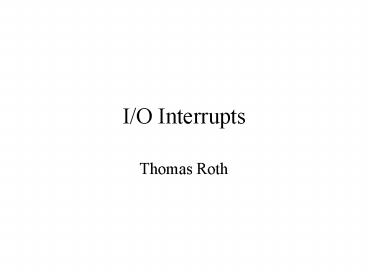IO Interrupts - PowerPoint PPT Presentation
1 / 16
Title: IO Interrupts
1
I/O Interrupts
- Thomas Roth
2
What is I/O inpterrupt
- I/O interrupts are the way the computer is forced
branched to the required subroutine - Subroutines are require to
- 1.Transfer a data word between an I/O device and
main storage (read/write operations) - 2. Checks conditions related to the I/O device
- 3. Handle the ending of the I/O device operation
3
How I/O interrupts are used in routine
instructions
- The diagram above is an example of a job program
routine - The branch from job routine to I/O routine occurs
at point A
4
I/O interrupts in routine instruction (continue)
- Branching occurs because the program is at a
point that the I/O operation is required. - E.G. the reading of a card in the card reader
- When the I/O routine ends, another branch is made
back to the job routine . - I/O routine and job routine dont overlap due to
the CPU executing only one instruction at a time. - Also , when the I/O device operation is started,
it continues as the program-instruction
execution takes place in the CPU.
5
Interrupted Action
- When the I/O device operation starts, and then
moved far enough to be read, then it give a
signal to the CPU ( which is a interrupt
request). - But also the interrupt doesnt occur until after
the current instruction has been completed. - Thus a forced branch occurs to an
interrupt-handling subroutine (more on interrupt
subroutine in later slide/s).
6
A example of a interrupted action
7
Interrupted action (continue)
- In order to return back to the program routine in
progress (before the interrupt happened), an
program-controlled branch is created. - This type of branch is NOT forced by the CPU.
8
Program-controlled branch
- In a program-controlled branch to an I/O routine,
a program has address information for the
branch-to location and (if needed) the return
address. - A CPU-forced branch must properly branch to the
proper subroutine and return, through another
branch, to the interrupted program at the end of
the subroutine. - At the time of the actual interrupt, the next
instructions address is in the
instruction-address register.
9
Interrupt Subroutine
- The first word of the interrupt-subroutine
location stores the next instruction at the time
of the interrupt that a CPU-enforced branch is
executed. - This branch is also a branch-and-store-IAR
instruction
10
format of a branch-and-store-IAR instruction
11
Interrupt Subroutine (continue)
- The contents of the instruction are kept in the
first word location of the interrupt subroutine
until necessary to branch back to the interrupted
program, which is when the interrupt is handled. - Also, when the program is originally loaded into
the system, the subroutine addresses are stored
into the interrupt vectors.
12
Saving Data used by The Interrupted Program
- Before machine registers and certain index are
used for data manipulation within the subroutine,
the interrupt subroutine must save their
contents, but only the ones being used by the
interrupt subroutine. - This must be maintained because the interrupted
program may use the same registers. - At the end, the affected registers contents are
loaded back into the core storages registers.
13
Causes of interrupts
- To determine what I/O device is causing a
interrupt, examine the interrupt-level staus
word, if necessary. - After the device that is causing the interrupt is
found, the device-status word is examined the
condition in the device that cause the interrupt
to happened.
14
Causes of interrupts ( continue)
- The program must determine which operation
occurs. - When the subroutine determines whether the
interrupt is for a read or punch (by addressing a
sense-device I/O control command) either one of
two actions happen - 1. For read response, a execute I/O instruction
addresses a read I/O control command that moves
the data word from the 1442 to core storage. - 2. For punch response, a execute I/O instruction
addresses a write I/O control command that moves
the data word from the core storage to the 1442
punch.
15
Causes of interrupts part 3
- After the end of the level-0 interrupt
subroutine, saved contents of registers are
loaded from core storage back into registers, and
a branch is made back to the interrupted program. - The interrupted-level stats words defined for
interrupt levels 1, 2, 3, 4, and 5. - After the words are loaded into the accumulator,
the device causing the interrupt can be determine
by the contents of the word. - After the device causing the interrupt is
determined, to determine the condition within the
device that caused the interrupt, a
sense-device-status command can be executed.
16
Sources
- Diagrams and facts are used from the following
places - http//www.ibm1130.net/functional/IOInterrupts.htm
l































